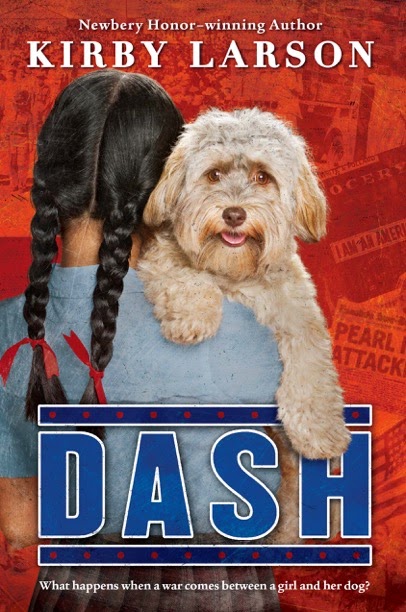Kirby Larson swings by readergirlz to chat with Janet Lee Carey about her new middle-grade novel, DASH.
KL – Thanks, Janet! It’s an honor to visit with you. And I am so delighted about the NAPPA award, as well as the two starred reviews, for my new book.
JLC - Tell us what inspired you to write Dash.
KL – I grew up on the West Coast and did not learn about the
“evacuation” of 120,000 people of Japanese descent – most of them American
citizens – during WWII until I was in college. I was shocked that something of
that magnitude could have been omitted from my education. So I began to try to
learn as much as I could about it; when I became a writer, I wanted to tell
stories from that time period in hopes that no other child would grow up in
ignorance about that shameful slice of history. One of the texts I read, Strawberry Days by Dave Niewert, had a
short snippet of an interview with a woman named Mitsue Shiraishi, who told
about being so heartbroken at the thought of having to leave her dog behind
during the “evacuation” that she wrote to the man in charge, General John
DeWitt, asking for permission to take her beloved Chubby to camp. He said “no,”
so now Mitsi had a few days to find a home for Chubby; fortunately, a kind
neighbor, Mrs. Charles Bovee, agreed to take him in.
Mrs. Charles knew how much Mitsi
loved her dog so she kept a diary, in Chubby’s voice, of his first weeks in the
Bovee household, and then mailed it to Mitsi at camp. Mitsi died as a very old
woman and when her family was cleaning out her apartment, they found that diary
in her nightstand. I was struck by the fact that of all the horrible things
that had happened to Mitsi, the thing she held onto was a symbol of kindness
and compassion. That heart hook into the story, plus the fact that I am madly
in love with my own dog and couldn’t imagine having to leave him behind, lead
me to write Dash.
JLC – Would you tell us a bit about your research, and give us a peek into your writing process?
KL – Do you have all day? ;-) As a researcher, I leave no stone
unturned. For example, when I read that snippet about Mitsi in Mr. Niewert’s
book, I began to reach out to everyone I knew in the Japanese American
community to see if I could find Mitsi’s family. I did and they generously
provided me with stories, photographs, and other ephemera to help me understand
what Mitsi went through. I listen to music of the time period I’m researching,
dig up recipes, put together outfits my characters might have worn (Pinterest
is great for this!), and even scour second hand stores and eBay for old
journals, letters and diaries to give me insights into the past. What I work
hardest to find are primary resources – they are essential for helping me
conjure up those delicious details that bring the past to life.
As for my writing process, it is a huge mess! I just jump in and start writing – no outline. No plan. What I do first, however, is get to know my character as thoroughly as possible. My work is very character driven.
JLC – The Kirkus
starred review says: “Mitsi
holds tight to her dream of the end of the war and her reunion with Dash.
Larson makes this terrible event in American history personal with the story of
one girl and her beloved pet.”
Would
you share the secret of writing historical fiction in a way that makes it personal
and real for young readers?
KL – I’m so flattered
by this lovely review. I wish I knew the secret! What I do know is that if I
don’t do my homework – really get myself grounded in a past time and place—I
would never stand a chance of making history personal.
JLC –
#WeNeedDiverseBooks is an important and long-awaited topic in the book world
right now. Thoughts?
KL- I am thrilled this conversation is taking place. Children need to see themselves – deserve to see themselves! -- in literature of all kinds. I do have a worry, however, that “diversity” could come to mean only ethnicity. It would be a shame to set such limits.
I’ve said this elsewhere: as a kid who grew up wearing hand me downs and sometimes finding the kitchen cupboards completely bare, I would have died and gone to heaven had I found books like Barbara O’Connor’s How to Steal a Dog or Janet Lee Carey’s The Double Life of Zoe Flynn, in which the main character is homeless. I hope and pray this #WeNeedDiverseBooks campaign leads to an even richer and broader range of the kinds of kid characters and stories we’ll see in children’s and young adult literature.
JLC— What would you like readers to take away from this book?
KL – I want readers to take away their own meaning from all of my books. But if Dash made readers stop and think about what it means to be a decent human being, I wouldn’t mind that one bit.
By Kirby Larson
Scholastic, 10/2014



No comments:
Post a Comment